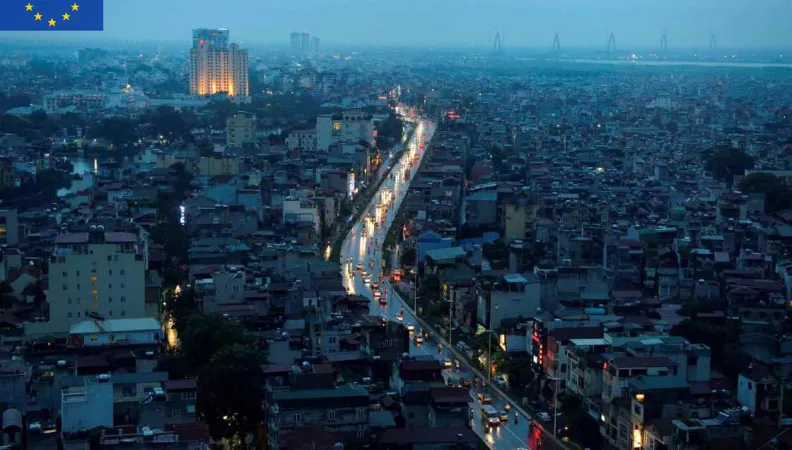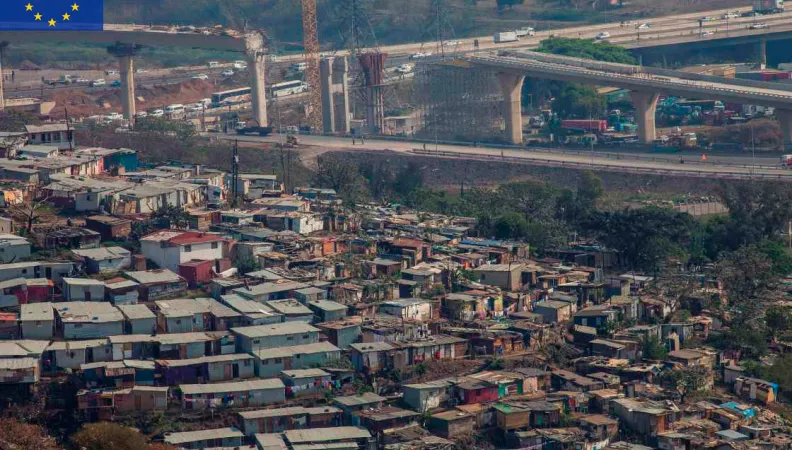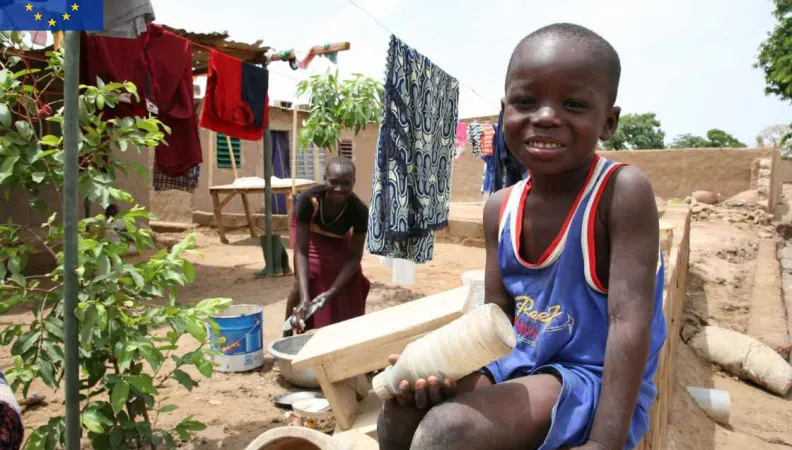 Legal notice EU (project) This project seeks to contribute to the goals of the research facility on inequalities through the analysis of multidimensional inequalities in Vietnam. The project will address the following key questions: What are the most relevant inequalities in Vietnam? What are the most critical inequality drivers ? What policies should national government prioritize to foster inequality reduction?
Legal notice EU (project) This project seeks to contribute to the goals of the research facility on inequalities through the analysis of multidimensional inequalities in Vietnam. The project will address the following key questions: What are the most relevant inequalities in Vietnam? What are the most critical inequality drivers ? What policies should national government prioritize to foster inequality reduction?This project also originally focused on the analysis of inequalities in Burkina Faso. However, this project has been suspended.
Contexte
Despite a significant progress in Vietnam in terms of growth, poverty reduction and even inequality reduction, efforts on inequality and human development issues still need to be done.
In Vietnam, nearly 30 million people have been lifted above the official poverty line over the last three decades, and the country's human development index (HDI) has risen significantly. However, data shows that income inequality in Vietnam has increased over the last two decades. According to the World Bank, the Gini index rose from 35.7 to 38.7 from 1992 to 2012. Besides, in 2014, there were 210 super-rich individuals in the country whose combined wealth stood around $20bn, which is equivalent to 12% of the country's GDP. In fact, according to Oxfam-Vietnam calculations, the richest man in Vietnam earns more in a day than the poorest Vietnamese earns in 10 years.
This project is part of the first phase of the Research Facility on Inequalities, coordinated by AFD and funded by the European Commission's Directorate-General for International Partnerships over the 2017-2020 period. The first phase of the Facility has led to the conduct of 22 research projects and the publication of around 100 research papers and policy briefs.
Objectif
The goal is to adopt a multidimensional approach to provide convincing analysis on inequality. This will focus especially on inequality of opportunities and voice in order to use this as a process to engage with relevant stakeholders, especially in the debates on policy options to tackle inequality, and in mid-term to use the MIF as a way to influence monitoring of SDG 10 in the country.
The specific goals are as follows:
- The "Oxfam Vietnam Inequality Framework" is developed, piloted and adopted to the Vietnamese context;
- The OVIF is used as a tool to enhance in-depth understanding on multiple dimensions of inequality (paying special attention to inequality in voices and opportunity) and identify concrete policy gaps to tackle inequality in Vietnam;
The OVIF research findings and methodology are shared with policy makers, research institutes, and other development institutions.
Méthode
The Multidimensional Inequality Framework is designed to capture the multidimensional nature of inequality, which is experienced across a number of 7 life domains, and that there are many different forms of inequality (such as concentrations of wealth, pay gaps, dispersion of income, social gradients in mortality, and greater social isolation experienced by the elderly). Within each of the 7 life domains, the framework offers a series of sub-domains and a number of indicators and measures which can be used to measure and monitor multidimensional inequality in a given context. Many of the indicators and measures suggested under each subdomain are related to the SDGs framework, which governments are already committed to monitor. This can be a useful element to guarantee at least a minimum level of data availability in all countries. Besides, the Oxfam Inequality Toolkit, which is a key companion for the practical implementation of the MIF in a given context, suggests several global databases, aside from national household surveys, to be used by teams willing to implement the framework.
Résultats
The research findings point at persisting, critical inequalities across several life domains. After conducting quantitative and qualitative analysis, the research identifies large gaps between subpopulation groups across spatial, socio-economic, and ethnic axes of inequality in their capability to enjoy the right to a proper, quality education and to experience a life free of illness and access to quality healthcare facilities. People belonging to ethnic minorities (EM), women, and people living in rural provinces are more affected by inequalities in health and education than the Kihn, men, and higher-income households living in predominantly urban areas.
Furthermore, inequality in the capability to participate, raise one’s voice, and influence public matters is extremely acute between men and women and the poorest households, with a lower level of education, compared to the richest, urban, highly educated households.
You may find the research paper and the policy brief here:
- Research paper: Multidimensional inequality in Vietnam
- Policy brief: Multidimensional inequality in Vietnam
Please find the presentation of the report "Multidimensional Inequalities in Vietnam” by Vu Thi Quynh Hoa (Head of Campaign & Advocacy in Oxfam Vietnam) and Dr. Phuong Duc Tung (Director of the Mekong Development Research Institute) during the second webinar of the AFD Research Conversations:
Contact:
- Anda David, Research Officer, AFD
 Legal notice EU (project) Inequality has emerged as the social challenge of the decade. Empirically, a series of influential studies of the available international evidence suggest that global inequality has been falling in the last quarter century. However, this encouraging trend appears to have been driven entirely by convergence in GDP per capita across nations and the consequent decline in inequality between countries, with the average inequality within countries remaining constant until the about 2000 but increasing thereafter.
Legal notice EU (project) Inequality has emerged as the social challenge of the decade. Empirically, a series of influential studies of the available international evidence suggest that global inequality has been falling in the last quarter century. However, this encouraging trend appears to have been driven entirely by convergence in GDP per capita across nations and the consequent decline in inequality between countries, with the average inequality within countries remaining constant until the about 2000 but increasing thereafter.
Context
The picture within Africa is more complex, and often obscured by problems with unreliable and non-comparable data, both over time and across countries. The most careful African data analysis suggests that, measured in monetary terms, African inequality is very high, Africa being the most unequal continent. There is, however, huge variation in the magnitude, changes and texture of this inequality across the continent.
This implies a double danger. Africa first needs to ensure that it is included in the international measurements. At least as importantly, the continent must also ensure that the particular contexts of its societies are considered in the analysis both of the factors causing inequality and the consequences of inequality. This analysis is absolutely crucial because it is the basis for policy interventions and civil society action, which are necessary to reverse the trend.
Given this context, a research project focusing on the development of diagnostic tools and capacity building was launched in partnership with the African Center of Excellence on Inequality Research (ACEIR) in the framework of the first phase of the Research Facility on Inequalities. The initial study (2018-2020) led to an in-depth analysis of inequalities in four countries: South Africa, Ghana, Kenya and Cote d’Ivoire. A Handbook on Inequality Measurement, which serves as a foundational guide for multidimensional inequality analysis, was also developed by ACEIR. The Handbook outlines key dimensions and indicators of inequality and provides guildelines for measuring income and beyond income inequalities.
This project was part of the first phase of the Research Facility on Inequalities, coordinated by AFD and funded by the European Commission's Directorate-General for International Partnerships over the 2017-2020 period. The first phase of the Facility has led to the conduct of 22 research projects and the publication of around 100 research papers and policy briefs.
Following the success of this research project:
- A fifth analysis was launched in Mozambique over the 2022-2024 period;
- A research project aming to expand and update the Handbook by incorporating methodologies for assessing vulnerabilities related to climate change and ecological transitions has also been launched over the 2024-2025 period.
Find out more
Goals
The main objective of this research project was to advance the analysis of African inequality and the policy discussion on strategies to overcome inequality in Africa through a series of country-level engagements. The project was given structure and impetus through the development of a diagnostic tool that was implemented in a limited number of pilot countries. This diagnostic tool consists of a thorough analysis of the various inequalities in a given country which enables the government to identify the priorities and policy options in order to reduce them.
In order to build the diagnostic tool, a Handbook was also developed to set up a common base which enabled country comparisons. To extend its use and improve accountability, it was backed with a central data hub and strong data centres in each partner country that allowed and facilitated further inequality analysis.
Existing multidimensional inequality analyses primarily concentrate on examining inequalities within the social and economic domains. While many low-income countries are severely impacted by climate change, there is a notable research gap in the analysis of inequalities related to climate vulnerabilities and their interactions with other socio-economic and environmental factors. The extension and updating of the Handbook, carried out over the period 2024-2025, aims to address this gap and provide the guidelines for integrating the analysis of climate-related inequalities in future diagnostics.
Method
The diagnostic tool is based on three pillars :
- a conceptual and empirical review of the studies on inequality in Africa, allowing us to have a baseline for the development of future projects, as well as a better comprehension of the specificities of inequalities in Africa and of their measurement;
- a Handbook which contains the framework proposed for the country inequality diagnostics, the methodological issues around the measurement of inequalities and their analysis and the important issues linked to policies;
- the support to the implementation of the country diagnostic, in collaboration with the pilot countries’ local research teams and the creation of the data hub.
In order to expand and update the Handbook, researchers will thoroughly examine and synthesise existing literature that addresses the measurement and analysis of climate-related vulnerabilities. This approach will help identify gaps in current research and propose a minimal set of indicators for measuring vulnerabilities linked to climate change and the imperatives of the ecological transition and detail appropriate data and measurement methods to enable their inclusion as part of an inequality diagnostic report.
Results
In practical terms, the country diagnostic takes the form of a report which overviews the inequality within a country, across all relevant dimensions, for a given time and over time. Alongside this, it summarises the main policies passed, or in place, expected to have an impact on inequalities. Each country will use their diagnostic as a platform:
- for policy engagements on strategies to overcome inequality,
- for the stimulation of national dialogue and a national research focus on inequality,
- to lead the national discussion through further, high impact research papers from the country node on inequality.
- The Handbook on Inequality Measurements for Country Studies: in order to insure a certain degree of comparability among all the country studies and to support researchers and statisticians in conducting inequality diagnostics, a Handbook was developed by the African Centre of Excellence for Inequality Research (ACEIR).
- A review on inequality in Sub-Saharan Africa: this research paper takes stock of what we know about African inequality both to promote better analysis and better policymaking in addressing inequality in Africa.
- The diagnostic of inequality in South Africa, carried out by Statistics South Africa in partnership with the Southern Africa Labour and Development Research Unit (SALDRU), ACEIR in the EU-AFD Facility framework: Inequality trends in South Africa: a multidimensional diagnosis of inequality
This report was presented at a workshop involving all actors working to reduce inequality (11 February 2020 in Philippi, Cape Town), on the occasion of the 30th anniversary of the release of Nelson Mandela. You will find here the synthesis of the workshop here: Stakeholder engagement on inequality trends in South Africa.
- The diagnostic of inequality in Ghana, conducted by ISSER and the University of Ghana in partnership with the ACEIR in the EU-AFD Facility framework: Inequality Diagnostics for Ghana
- The diagnostic of inequality in Kenya, conducted by University of Nairobi in partnership with ACEIR in the EU-AFD Facility framework: Inequality Diagnostics for Kenya
- An in-depth analysis of inequality in Côte d'Ivoire (in French)
- An analysis on the dynamics of social inequalities in Mozambique, conducted by Instituto de estudos sociais e economicos (IESE) and the University of Cape Town in partnership with ACEIR in the EU-AFD Facility framework
- The research project aming to expand and update the Handbook will result in:
- A research paper that conceptualizes the links between inequalities, climate change and the ecological transition in low and middle income countries (in progress);
- An updated edition of the Inequality Handbook that integrates key metrics of climate change's impact on inequality (in progress).
Contacts
- Anda David, Research Officer, AFD
- Rawane Yasser, Junior Research Officer, AFD
 Legal notice EU (project) Burkina Faso has enjoyed relatively strong economic growth throughout the past ten years (more than 5% per year on average). Nevertheless, a non-negligible portion of the country’s population lives below the poverty line (40% in 2014). Thorough analysis is needed to better understand the many challenges posed by this level of inequality.
Legal notice EU (project) Burkina Faso has enjoyed relatively strong economic growth throughout the past ten years (more than 5% per year on average). Nevertheless, a non-negligible portion of the country’s population lives below the poverty line (40% in 2014). Thorough analysis is needed to better understand the many challenges posed by this level of inequality.
Context
Between 2007 and 2013, the average annual growth rate of Burkina Faso’s gross domestic product (GDP) was approximately 7% per year in real terms, representing one of the best economic performances in West Africa. If we take into account the country’s strong population growth, the average rate of per-capita GDP rose by 3% per year during this same period. Meanwhile, the poverty rate grew from 45% in 1994 to 47% in 2009. Despite signs of a decline (40% in 2014), considerable inequalities remain.
This project is part of the first phase of the Research Facility on Inequalities, coordinated by AFD and funded by the European Commission's Directorate-General for International Partnerships over the 2017-2020 period. The first phase of the Facility has led to the conduct of 22 research projects and the publication of around 100 research papers and policy briefs.
Goal
The initial objective of this research program on inequalities in Burkina Faso is to create an inequality diagnostic in the country. In a second phase, scientific studies will be carried out on three themes:
- The dynamics of inequalities and of multidimensional poverty;
- Educational trajectories; and
- What happens to graduates of the educational system.
The objective here is to examine how school graduates become integrated into society later, and to what degree they put into practice the skills acquired at school.
The research will mainly concern the cities of Ouagadougou and Nouna, in western Burkina Faso.
Method
The diagnostic on inequalities will take stock of the situation in Burkina Faso through a literature review and analysis of data from national surveys. The dynamics of inequalities and of multidimensional poverty in Burkina Faso will be understood through the experiences of one of the partners of this project, the Ouagadougou and Nouna Observatories. Analysis of trends in inequalities and in multidimensional poverty over time will be carried out in urban, semi-urban, and rural areas, according to the demographic, social, and economic characteristics of households and to the degrees of poverty. Research on the educational trajectories and on what has become of people having graduated from the educational system will use the same data. The idea is to monitor cohorts of school graduates to study their trajectories and their integration into the society in the longer term.
Results
This research will give rise to conferences and workshops. Various publications are also planned: a report, policy briefs, and research articles.
You may find the research papers here (in French) :
- Etat des lieux des inégalités multi-dimensionnelles au Burkina Faso
- Les inégalités au Burkina Faso à l'aune de la pandémie de la Covid-19: quelques réfléxions prospectives
- Dynamique des inégalités et de la pauvreté multi-dimensionnelle à Nouna
- Dynamique des inégalités de la pauvreté multi-dimensionnelle à Ouagadougou : données de l'Observatoire de population de Ouagadougou
You may also find the policy briefs:
- Meeting the equity challenge in Burkina Faso: regional policies to reduce economic inequalities
- Improving access to education in Burkina Faso: a major condition for benefiting from the demographic dividend
And the policy dialogue: Improving access to education in Burkina Faso: A major condition for benefiting from the demographic dividend
Contacts:
- Linda Zanfini, Research Officer, AFD
- Rohen d'Aiglepierre, Research Officer, AFD
